Parkside PSSA 3.6 C3 User Manual [cs, en, de, pl]

CORDLESS SCREWDRIVER PSSA 3.6 C3
CORDLESS SCREWDRIVER |
AKUMULATOROWA WKRETARKA |
Translation of the original instructions |
Tłumaczenie oryginalnej instrukcji obsługi |
|
|
AKKUS RÚDCSAVAROZÓ |
AKU ŠROUBOVÁK |
Az originál használati utasítás fordítása |
Překlad originálního provozního návodu |
AKUMULÁTOROVÝ SKRUTKOVAC |
AKKU-STABSCHRAUBER |
Preklad originá lneho návodu na obsluhu |
Originalbetriebsanleitung |
IAN 104021

Before reading, unfold the page containing the illustrations and familiarise yourself with all functions of the device.
Przed przeczytaniem proszę rozłożyć stronę z ilustracjami, a następnie proszę zapoznać się z wszystkimi funkcjami urządzenia.
Olvasás előtt kattintson az ábrát tartalmazó oldalra és végezetül ismerje meg a készülék mindegyik funkcióját.
Před čtením si otevřete stranu s obrázky a potom se seznamte se všemi funkcemi přístroje.
Pred čítaním si odklopte stranu s obrázkami a potom sa oboznámte so všetkými funkciami prístroja.
Klappen Sie vor dem Lesen die Seite mit den Abbildungen aus und machen Sie sich anschließend mit allen Funktionen des Gerätes vertraut.
GB |
Translation of the original instructions |
Page |
4 |
|
PL |
Tłumaczenie oryginalnej instrukcji obsługi |
Strona |
16 |
|
HU |
Az originál használati utasítás fordítása |
Oldal |
29 |
|
CZ |
Překlad originálního provozního návodu |
Strana |
42 |
|
SK |
Preklad originálneho návodu na obsluhu |
Strana |
54 |
|
DE / AT / CH |
Originalbetriebsanleitung |
Seite |
66 |
|
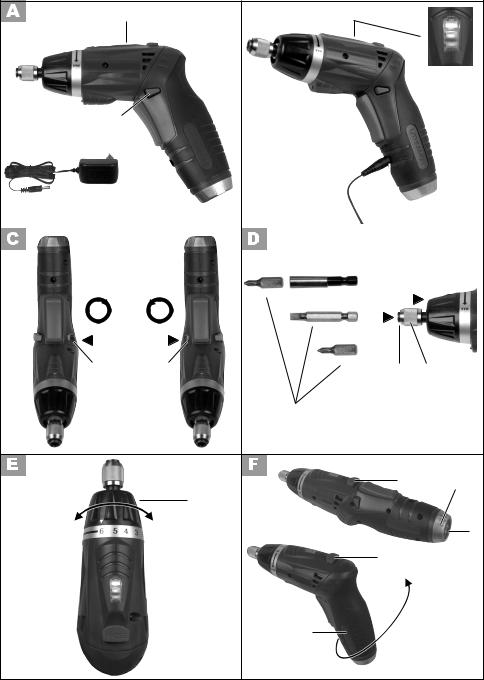
|
|
2 |
3 |
4 |
|
|
|
|
|
3 |
|
|
|
|
|
|
||||||||||||||||
1 |
|
|
|
|
|
|
|
|
|
|
|
|
|
|
|
|
|
|
|
|
|
|
|
|
|
|
|
|
|
|
||
|
|
|
|
|
|
|
|
|
|
|
|
|
|
|
|
|
|
|
|
|
|
|
|
|
|
|
|
|
|
|
|
|
|
|
|
|
|
|
|
|
|
|
|
|
|
|
|
|
|
|
|
|
|
|
|
|
|
|
|
|
|
|
|
|
|
|
|
|
|
|
|
|
|
|
|
|
|
|
|
|
|
|
|
|
|
|
|
|
|
|
|
|
|
|
|
|
|
|
|
|
|
|
|
|
|
|
|
|
|
|
|
|
|
|
|
|
|
|
|
|
|
|
|
|
|
|
|
|
|
||
|
|
|
|
|
|
|
|
|
|
|
|
|
|
|
|
|
|
|
|
|
|
|
|
|
|
|
|
|
|
|
|
|
11 |
10 |
|
|
9 |
|
|
|
|
|
|
|
|
|
|
|
|
|
|
|
|
|
|
|
|
||||||||
|
|
|
|
|
|
|
|
|
|
|
|
|
|
|
|
|
|
|
|
|
|
|||||||||||
|
|
|
|
|
|
|
|
|
|
|
|
|
|
|
|
|
|
|
|
|
|
|
|
|
|
|||||||
|
|
|
|
|
|
8 |
|
|
|
|
|
|
|
|
|
|
12 |
|
|
|
|
|
|
|
||||||||
|
|
|
|
|
|
|
7 |
|
|
|
|
|
|
|
|
|
|
|
|
|
|
|
||||||||||
|
|
|
|
|
|
|
|
|
|
|
|
|
|
|
|
|
|
|
|
|
|
|
|
|
|
|
|
|
||||
|
|
|
|
|
|
|
|
|
|
|
|
|
|
|
|
|
|
|
|
|
|
|
|
|
|
|
|
|
||||
|
|
|
|
|
|
|
|
|
|
|
|
|
|
|
|
|
|
|
|
|
|
|
|
|
|
|
|
|
||||
|
|
|
|
|
|
|
|
|
|
|
|
|
|
6 |
|
|
|
|
|
|
|
|
|
|
|
|
|
|
|
|
|
|
|
|
|
|
|
|
|
|
|
|
|
|
|
|
|
|
|
|
|
|
|
|
|
|
|
|
|
|
|
|
|||
|
|
|
|
|
|
|
|
|
|
|
|
|
|
|
|
|
|
|
|
|
|
|
|
|
|
|
|
|
|
|
|
|
|
|
|
|
|
|
|
|
|
|
|
|
|
|
|
|
|
|
|
|
|
|
|
|
|
|
|
|
|
|
|
|
|
|
|
|
|
|
|
|
|
|
|
|
|
|
|
|
|
|
|
|
|
|
|
|
7 |
|
|
|||||||
|
|
12 |
|
|
13 |
|
|
|
|
|
|
|
|
|
|
|
|
|||||||||||||||
|
|
|
|
|
|
|
|
|
|
|
|
|
|
5 |
|
|
||||||||||||||||
|
|
|
|
|
|
|
|
|
|
|
|
|
|
|
|
|
|
|
|
|
|
|
|
|
|
|
|
|
|
|
||
|
|
|
|
|
|
|
|
|
|
|
|
|
|
|
|
|
|
|
|
|
|
|
15 |
|
|
|
|
|
|
|
||
|
|
|
|
|
|
|
|
|
|
|
|
|
|
|
|
|
|
|
|
|
|
|
|
|
|
|
|
|
|
|
|
|
|
|
|
|
|
|
|
|
|
|
|
|
|
|
|
|
|
|
|
|
|
|
|
|
|
|
|
|
|
|
|
|
|
|
|
|
|
|
|
|
|
|
|
|
|
|
|
|
|
|
|
|
|
|
|
|
|
|
|
|
|
|
|
|
|
|
|
|
|
|
|
|
|
|
|
|
|
|
|
|
|
|
|
|
|
|
|
|
|
|
|
|
|
|
|
|
|
|
|
|
|
|
|
|
|
|
|
|
|
|
|
|
|
|
|
|
|
|
|
|
|
|
|
|
|
|
|
|
|
|
|
|
|
|
|
|
|
|
|
|
|
|
|
|
|
|
|
|
|
|
|
|
|
|
|
|
|
|
|
|
|
|
|
|
|
|
|
|
|
|
|
|
|
|
|
|
|
|
|
|
|
|
|
|
|
|
|
|
|
|
|
|
|
|
|
|
|
|
9 |
9 |
11 |
1 |
14
4 6
2
5
4
6

GB |
|
Contents |
|
Introduction.................................. |
4 |
Intended use................................. |
4 |
General description...................... |
5 |
Extent of the delivery......................... |
5 |
Overview........................................ |
5 |
Function description.......................... |
5 |
Technical data............................... |
6 |
Safety information........................ |
6 |
Symbols.......................................... |
6 |
General safety instructions for power |
|
tools................................................ |
7 |
Correct handling of the battery |
|
charger......................................... |
10 |
Charging process........................ |
10 |
Charging the battery....................... |
11 |
Initial Operation......................... |
11 |
Switching ON and OFF................... |
11 |
Checking the charge status of the |
|
rechargeable battery....................... |
11 |
Set the direction of rotation.............. |
11 |
Inserting/replacing bits................... |
12 |
Torque setting................................. |
12 |
Handle setting................................ |
12 |
Use as a torch................................ |
12 |
Cleaning/Maintenance................ |
12 |
Cleaning....................................... |
12 |
Maintenance.................................. |
13 |
Storage...................................... |
13 |
Disposal and the environment.... |
13 |
Spare parts/Accessories.............. |
13 |
Guarantee.................................. |
14 |
Repair Service............................ |
15 |
Service-Center............................ |
15 |
Importer..................................... |
15 |
Translation of the original EC |
|
declaration of conformity............ |
79 |
4
Introduction
Congratulations on the purchase of your new device. With it, you have chosen a high quality product. During production, this equipment has been checked for quality and subjected to a final inspection. The functionality of your equipment is therefore guaranteed.
The operating instructions constitute part of this product. They contain
important information on safety, use and disposal.
Before using the product, familiarise yourself with all of the operating and safety instructions. Use the product only as described and for the applications specified. Keep this manual safely and in the event that the product is passed on, hand over all documents to the third party.
Intended use
The device is intended for drilling screws in and out in wood, metal or plastic and for light drilling operations. The device is not suitable for commercial use.
Any other use not specifically mentioned in this manual can lead to damage to the unit and may present a serious hazard to the user.
The manufacturer will not be held responsible for damage or injuries caused by use outside that stipulated by the manual or by improper handling.
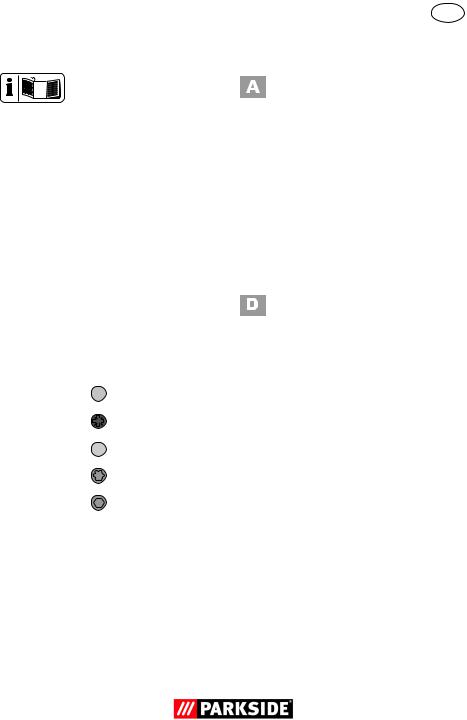
General description
The illustration of the principal functioning parts can be found on the front and back foldout pages.
Extent of the delivery
Carefully unpack the appliance and check that it is complete.
Dispose of the packaging material correctly.
-Cordless screwdriver
-Charger
-26 bits
-1 Bit holder
-Case
-Instruction Manual
26 bits:
Slot |
SL |
|
|
|
|
|
|
|
|
|
25mm |
No. |
3 |
• 4 • 5 • 6 • 7 |
|
|
|
|
|
|
|
|
|
50mm |
No. |
5 |
|
||
|
|
|
|
|
|
|
|
|
||||||
|
|
|
|
|
|
|
|
|
|
|
|
|||
|
|
|
|
|
|
|
|
|
|
|
|
|
|
|
Cross |
PZ |
|
|
|
|
|
|
|
|
|
25mm |
No. |
0 • 2 x 1• 2 x 2• 3 |
|
|
|
|
|
|
|
|
|
|
50mm |
No. |
2 |
|
||
|
|
|
|
|
|
|
|
|
|
|
|
|||
|
|
|
|
|
|
|
|
|
|
|
|
|
|
|
Cross |
PH |
|
|
|
|
|
|
|
|
|
25mm |
No. |
0 • 2 x 1• 2 x 2• 3 |
|
|
|
|
|
|
|
|
|
|
|
|
|
|
|
|
Torx |
T |
|
|
|
|
|
|
|
|
|
25mm |
No. |
10• 15 • 20 • 25 |
|
|
|
|
|
|
|
|
|
|
|
|
|
|
|
|
Hexagonal |
H |
|
|
|
|
|
|
|
|
|
25mm |
No. |
3 |
• 4 • 5 |
|
|
|
|
|
|
|
|
|
|
|
|
|
|
|
GB
Overview
1Spring sleeve
2Torque setting
3Battery Indicator (not visible)
4Release key for handle setting
5Torch
6Handle
7Charging socket
8On/Off switch
9Direction switch
10LED work light
11Bit adapter
12Charging cable connector
13Charger
14Bits
15Bit holder
Function description
The cordless screwdriver with clockwise/ anticlockwise rotation has 6 torque steps, one drilling level and one LED work light. Furthermore, the device can be used as a torch.
Please read the following descriptions for the function of the various controlling parts of the unit.
5

GB
Technical data
Unit |
|
|
|
|
|
|
|
|
Motor voltage................. |
|
3.6 V |
|
|
1.5 Ah |
|||
|
|
|
||||||
Rated speed (n0)........................ |
|
|
|
200 min-1 |
||||
Torque................................... |
|
|
max. 4 Nm |
|||||
Protection class............................... |
|
|
|
|
|
III III |
||
Weight (without charger).............. |
|
|
|
0.43 kg |
||||
Sound pressure level (LpA)......... |
|
55.4 dB(A) |
||||||
Sound................................................power level (LwA) |
|
|
|
K= 3 dB |
||||
|
66.4 dB(A) |
|||||||
Vibration................................................(a ) |
|
|
|
|
K= 3 dB |
|||
0.37 m/s2, K= 1.5 m/s2 |
||||||||
h |
|
|
|
|
|
|
|
|
Battery (Li-Ion) |
|
|
|
|
|
|
|
|
Battery cells...................................... |
|
|
|
1 |
||||
Nominal voltage....................... |
|
|
|
|
3.6 V |
|
|
|
|
|
|
|
|||||
Capacity.................................. |
|
|
|
|
|
1.5 Ah |
||
Loading time............................. |
|
|
|
|
|
ca. 3 h |
||
Charger................ |
IVP0550-0550W |
|||||||
Nominal consumption.................. |
|
|
|
|
48 W |
|||
Voltage input..................... |
|
100-240 V~, |
||||||
................................... |
|
50/60 Hz, 0.2 A |
||||||
Voltage Output........... |
5.5 V |
|
|
550 mA |
||||
|
|
|||||||
Output rating........................ |
|
|
|
max. 6 W |
||||
Protection class.............................. |
|
|
|
|
|
|
II |
|
Protection category....................... |
|
|
|
|
IPX0 |
|||
The noise and vibration levels have been calculated according to the norms stated in the conformity statement. Technical and optical alterations to serve progress may be made without notice. All measurements, instructions and other data given in this manual are therefore given without guarantee of correctness. Legal claims made on the basis of this manual are therefore excluded.
The stated vibration emission value was measured in accordance with a standard testing procedure and may be used to compare one power tool to another. The stated
vibration emission value may also be used for a preliminary exposure assessment.
Warning: The vibration emission value may differ during actual use of the power tool from the stated value depending on the manner in which the power tool is used.Safety precautions aimed at protecting the user should be based on estimated exposure under actual usage conditions (all parts of the operating cycle are to be considered, including, for example, times during which the power tool is turned off and times when the tool is turned on but is running idle).
Safety information
When using the device, please observe the safety instructions.
Symbols
Symbols in the manual
Warning symbols (instead of the exclamation mark, the danger may be explained) with information on damage and injury prevention.
Instruction symbols (the instruction may be explained at the place of the exclamation mark) with information on preventing damage.
Help symbols with information on improving tool handling.
6
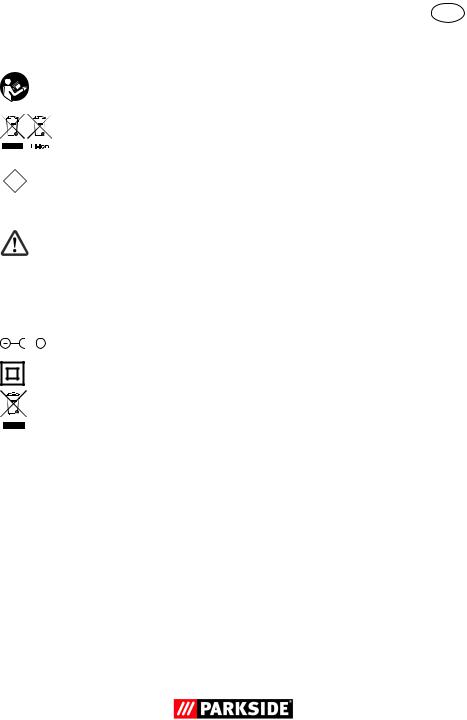
Symbols on the unit
Before using for the first time, carefully read through the user manual.
Do not dispose of the device with the battery installed in household waste.
III |
Protection class III |
Symbols on the charger
Attention!
 Read the manual.
Read the manual.
 The charger is for indoor use only.
The charger is for indoor use only. 
 Pole orientation
Pole orientation
Protection class II
Electric devices do not belong with domestic waste.
General safety instructions for power tools
WARNING! Read all safety directions and instructions.
Omissions in the compliance with safety directions and instructions can cause electrical shock, fire and/or severe injuries.
Retain all safety directions and instructions for future use.
The term “Power Tools” used in the safety instructions refers to mains-operated power tools (with power cord) and to battery-op- erated power tools (without power cord).
GB
1) WORK AREA SAFETY
a)Keep work area clean and well lit. Cluttered or dark areas invite accidents.
b)Do not operate power tools in explosive atmospheres, such as in the presence of flammable
Iiquids, gases or dust. Power tools create sparks which may ignite the dust or fumes.
c)Keep children and bystanders away while operating a power tool. Distractions can cause you to lose control.
2) ELECTRICAL SAFETY
a)Power tool plugs must match the outlet. Never modify the plug in any way. Do not use any adapter plugs with earthed (grounded) power tools. Unmodified plugs and matching outlets will reduce risk of electric shock.
b)Avoid body contact with earthed or grounded surfaces, such as pipes, radiators, ranges and refrigerators. There is an increased risk of electric shock if your body is earthed or grounded.
c)Do not expose power tools to rain or wet conditions. Water entering a power tool will increase the risk of electric shock.
d)Do not abuse the cord. Never use the cord for carrying, pulling or unplugging the power tool. Keep cord away from heat, oil, sharp edges or moving parts.
Damaged or entangled cords increase the risk of electric shock.
e)When operating a power tool
7

GB
outdoors, use an extension cord suitable for outdoor use. Use of a
cord suitable for outdoor use reduces the risk of electric shock.
f)If operating a power tool in a damp location is unavoidable, use a residual current device (RCD) protected supply. Use of an RCD reduces the risk of electric shock.
3) PERSONAL SAFETY
a)Stay alert, watch what you are doing and use common sense when operating a power tool. Do not use a power tool while you are tired or under the influence of drugs, alcohol or medication. A moment of inattention white operating power tools may result in serious personal injury.
b)Use personal protective equipment. Always wear eye protection. Protective equipment such as dust mask, non-skid safety shoes, hard hat, or hearing protection used for appropriate conditions will reduce personal injuries.
c)Prevent unintentional starting. Ensure the switch is in the offposition before connecting to power source and/or battery pack, picking up or carrying the tool. Carrying power tools with your finger on the switch or energising power tools that have the switch on invites accidents.
d)Remove any adjusting key or wrench before turning the power tool on. A wrench or a key left attached to a rotating part of the power tool may result in personal injury.
e)Do not overreach. Keep proper
8
footing and balance at all times.
This enables better control of the power tool in unexpected situations.
f)Dress properly. Do not wear loose clothing or jewellery. Keep your hair, clothing and gloves away from moving parts. Loose clothes, jewellery or long hair can be caught in moving parts.
g)If devices are provided for the connection of dust extraction and collection facilities, ensure these are connected and properly used. Use of dust collection can reduce dust-related hazards.
4) POWER TOOL USE AND CARE
a)Do not force the power tool. Use the correct power tool for your application. The correct power tool will do the job better and safer at the rate for which it was designed.
b)Do not use the power tool if the switch does not turn it on and off. Any power tool that cannot be controlled with the switch is dangerous and must be repaired.
c)Disconnect the plug from the power source and/or the battery pack from the power tool before making any adjust -ments, changing accessories, or storing power tools. Such preventive safety measures reduce the risk of starting the power tool accidentaIly.
d)Store idle power tools out of the reach of children and do not allow persons unfamiliar with the power tool or these instructions to operate the power tool. Power tools are dangerous in the hands of untrained users.

e)Maintain power tools. Check for misalignment or binding of moving parts, breakage of parts and any other condition
that may affect the power tool’s operation. If damaged, have the power tool repaired before use. Many accidents are caused by poorly maintained power tools.
f)Keep cutting tools sharp and clean. Properly maintained cutting tools with sharp cutting edges are less Iikely to bind and are easier to control.
g)Use the power tool, accessories and tool bits etc. in accordance with these instructions, taking into account the working conditions and the work to be performed. Use of the power tool for operations different from those intended could result in a hazardous situation.
h)Hold the device by the insulated gripping surfaces when performing work in which the cutting tool may come into contact with hidden wiring or its own cord. Contact with a live wire can also cause a charge in metal parts of the device and result in an electric shock.
5)CAREFUL HANDLING AND USE OF BATTERY DEVICES
a)Charge the batteries only in chargers that are recommended by the manufacturer. Risk of fire if a charger that is suitable for a specific type of battery is used with other batteries.
b)In the power tools, use only the batteries designed for the purpose. The use of other batteries may result in injuries and risk of fire.
GB
c)Keep the unused battery away from paper clips, coins, keys, nails, screws and other small metal objects, which could cause bridging of the contacts. A short circuit between the battery contacts may cause burns or fire.
d)If used incorrectly, liquid may leak from the battery. Avoid contact with this. In the event of accidental contact, rinse off
with water. If the liquid gets into eyes, seek medical assistance.
Leaking battery fluid may cause skin irritations or burns.
6) SERVICE
a)Have your power tool serviced by a qualified repair person using only identical replacement parts. This will ensure that the safety of the power tool is maintained.
7)SPECIAL SAFETY DIRECTIONS FOR BATTERY-OPERATED TOOLS
a)Do not subject the battery to strong sunlight over long periods and do not leave it on a heater. Heat damages the battery and there is a risk of explosion.
b)Allow a hot battery to cool before charging.
c)Do not open up the battery and avoid mechanical damage to the battery. Risk of short circuit and fumes may be emitted that irritate the respiratory tract. Ensure fresh air and seek medical assistance in the event of discomfort.
9
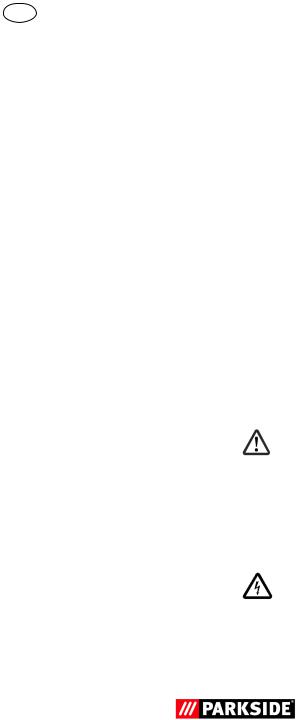
GB
Correct handling of the battery charger
a)This appliance can be used by persons with reduced physical, sensory or mental capabilities or lack of experience and knowledge if they have been given supervision or instruction
concerning use of the appliance in a safe way and understand the hazards involved. Children shall not play with the appliance.
b)Do not use the charger to charge non-rechargeable batteries.
c)To charge the battery, use only
the charger supplied. Risk of fire and explosion. This ensures that the safety of the device is maintained.
d)Before each use, check the charger, cable and plug and have them repaired by qualified professionals and only with original parts. Do not use a defective charger and do not open it up yourself. This ensures that the safety of the device is maintained.
e)Connect the charger only to a socket with an earth. Ensure that the mains voltage matches the specifications on the charger rating plate. Risk of electric shock.
f)Disconnect the charger from the mains before closing or opening connection to the battery / power tool / device. This ensures that the battery and charger are not damaged.
g)Keep the charger clean and away from wet and rain. Do not use the charger outdoors. Dirt
10
and the entry of water increase the risk of electric shock.
h)Operate the charger only with the appropriate original batteries. Charging other batteries may result in injuries and risk of fire.
i)Avoid mechanical damage to the charger. This can result in internal short circuits.
j)Do not operate the charger on a combustible surface (e.g. paper, textiles). Risk of fire due to heating during charging.
k)In order to minimise the risk of electric shock, pull the charger plug out of the socket prior to cleaning it.
l)If the power cable for this equipment is damaged, it must be replaced by the manufacturer,
a customer service agent of the same or a similarly qualified person in order to prevent hazards.
Charging process
Do not expose the battery to extreme conditions such as heat and impact. There is a risk of injury from leaking electrolyte solution! In case of contact, rinse with water or neutraliser and consult a doctor if contact has occurred with eyes etc.
Charge the battery only in dry areas.
There is a risk of injury from electric shock.

Ensure that the equipment is charged for no longer than 3 hours without interruption. The battery and equipment could be damaged and they consume energy unnecessarily in case of longer charging time. Overcharging invalidates the guarantee.
•The device may only be powered with SELV (Safety Extra Low Voltage) as marked on the device.
•Before initial use, charge the battery installed in the equipment. Do not charge the battery for several short periods in succession.
•Use the charger supplied to charge the Li-ion battery installed in the equipment.
•Recharge the battery if the equipment runs too slowly.
•In all cases, observe the applicable safety information as well as the regulations and directions for environmental protection.
•Defects resulting from improper handling are not subject to the guarantee.
Charging the battery
GB
Initial Operation
Switching ON and OFF
1.Press the on/off switch (8) to start the device. The LED work light
(10)lights up during operation.
2.To turn it off, release the on/off switch (8).
Overload protection: The safety cut-off of the device switches off in case of overload. Release the On/Off switch, the device can be switched on again after a few seconds.
Checking the charge status of the rechargeable battery
The battery indicator (  3) signalises the state of charge of the battery.
3) signalises the state of charge of the battery.
•Press the On/Off switch, the state of charge of the battery is displayed by
turning on the 3 coloured LED lights:
Green LED lights up brightly: Battery is
fully charged.
Red and yellow LEDs light up brightly:
Battery has a residual charge (< 90 %).
Red LED lights up brightly: Battery is empty, please charge.
1.Connect the charging cable con- Set the direction of rotation nector (12) with the charging
|
socket (7) of the device. |
|
You can select the direction of rotation with |
||||||||||
2. |
Plug the charger ( |
|
13) into an |
the direction switch (clockwise and anti- |
|||||||||
|
electrical outlet. |
|
|
|
clockwise direction) and secure the device |
||||||||
3. |
The battery indicator (3) lights |
against accidental start up. |
|||||||||||
|
up: |
|
|
|
|
|
|
|
|
|
|
|
|
|
Red LED lights up: |
|
|
|
|
1. |
Wait for the device to shut-down. |
||||||
|
|
|
|
|
|||||||||
|
Battery charging. |
|
|
|
|
2. |
Clockwise direction: |
|
|
|
|
|
|
|
|
|
|
|
|
||||||||
|
|
|
|
|
|||||||||
|
Green LED lights up: |
|
|
|
|
|
Press direction switch (9) to |
|
|
|
|||
|
Battery is charged. |
|
|
|
|
|
the right. |
||||||
4. |
After the charging process, |
|
3. |
Anticlockwise direction: |
|
|
|
||||||
|
|
|
|
||||||||||
|
|
||||||||||||
|
disconnect the charger ( |
|
13) |
|
|
Press direction switch (9) to |
|
|
|
||||
|
|
|
|
|
|||||||||
|
from the mains supply. |
|
|
|
the left. |
|
|||||||
|
|
|
|
|
|||||||||
11
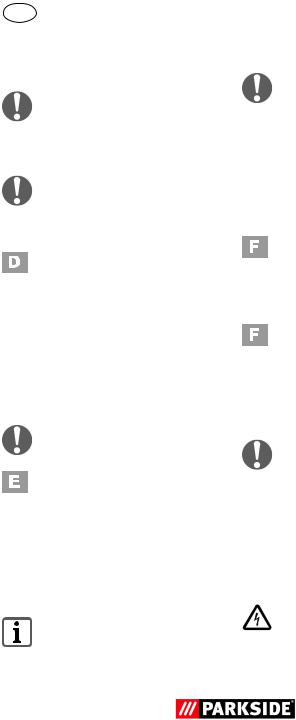
GB
4.Switch lock: Bring direction switch to neutral position.
Direction switch may only be activated at a standstill to prevent damage to the transmission.
Inserting/replacing bits
Prior to commencing any work on the device, bring the direction switch
( 9) to the neutral position in order to prevent an accidental start up.
9) to the neutral position in order to prevent an accidental start up.
1.Insert the desired bit (14) or bit holder (15) into the bit adapter (11). It locks into place audibly.
2.To remove the bit or bit holder pull the spring sleeve (1) back.
3.With the spring sleeve (1) pulled back remove the bit or bit holder from the bit adapter (11). Release the spring sleeve.
Torque setting
Always turn off the device, before setting the torque.
1.Turn the adjusting ring (2) to select the desired torque:
Step 1 --> lowest torque, Step MAX --> highest torque
(4 Nm).
Screws: Steps 1 - 6
Drilling: Step MAX.
2.Start with a lower torque step and increase according to requirement.
The necessary torque is dependent on: - the type and hardness of the
material to be treated;
-the type and length of the screws used.
12
Handle setting
Prior to commencing any work on the device, bring the direction
switch (  9) to the neutral position in order to prevent an accidental start up.
9) to the neutral position in order to prevent an accidental start up.
The device can be locked in two hand settings:
-Pistol grip position
-Rod position
Press the release key PRESS (4) and turn the handle (6) of the device by 180°. It locks into place audibly.
Use as a torch
1.Press the torch lens (5) on the underside of the handle (6). The torch LEDs light up.
2.To switch off the LEDs press the torch lens (5) again.
Cleaning/Maintenance
Leave any work not covered in this manual to our Service Centre. Only use original parts. There is a risk of injury!
Cleaning
Clean and service the device regularly as follows. This guarantees a long life for your unit:
Do not jet water onto the appliance and do not clean it under flowing water. This would result in the danger of an electric shock and the appliance could be damaged.
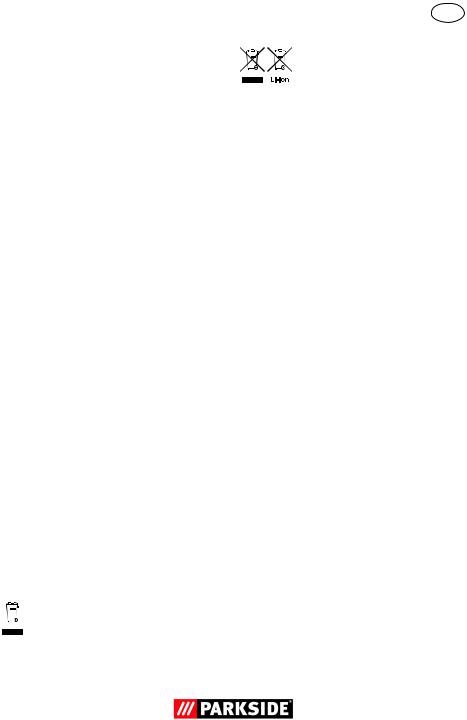
•Keep the ventilation slits, motor housing and handles on the equipment clean. To do this, use a damp cloth or brush.
Never use cleaning agents or solvents, which can cause irreparable damage to the unit.
Maintenance
The device is maintenance free.
Storage
•Keep the device in the blade guard supplied, dry and out of reach of children.
•Store the battery only in a partially charged state. The state of charge should be 40 – 60 % over a longer storage period.
•Store the device between 10° C and 25° C. During storage, avoid extreme cold or heat so the battery does not lose power.
•During a longer storage period, check the state of charge of the battery and recharge if necessary roughly every
3 months.
Disposal and the environment
Be environmentally friendly. Return the tool, accessories and packaging to a recycling centre when you have finished with them.
Machines do not belong with domestic waste.
GB
Do not dispose of the device with the battery installed in household waste, fire (risk of explosion) or water. Damaged batteries may damage the environment and your health if toxic fumes or liquids leak out.
•Dispose of the equipment with the battery discharged. Do not open the equipment or the battery.
•Dispose of the equipment in accordance with the local regulations. Take the equipment to a collection point, where it will be recycled in an environmentally friendly manner. For information about this, ask your local waste management company or our service centre.
•Defective units returned to us will be disposed of for free.
Spare parts/Accessories
Spare parts and accessories can be obtained at www.grizzly-service.eu
If you do not have internet access, please contact the Service Centre via telephone (see “Service-Center” page 15). Please have the order number mentioned below ready.
26 Bits.................................. |
91104080 |
Bit holder............................... |
91104081 |
Charger EU............................ |
80001073 |
13

GB
Guarantee
Dear Customer,
This equipment is provided with a 3-year guarantee from the date of purchase.
In case of defects, you have statutory rights against the seller of the product. These statutory rights are not restricted by our guarantee presented below.
Terms of Guarantee
The term of the guarantee begins on the date of purchase. Please retain the original receipt. This document is required as proof of purchase.
If a material or manufacturing defect occurs within three years of the date of purchase of this product, we will repair or replace – at our choice – the product for you free of charge. This guarantee requires the defective equipment and proof of purchase to be presented within the three-year period with a brief written description of what constitutes the defect and when it occurred.
If the defect is covered by our guarantee, you will receive either the repaired product or a new product. No new guarantee period begins on repair or replacement of the product.
Guarantee Period and Statutory Claims for Defects
The guarantee period is not extended by the guarantee service. This also applies for replaced or repaired parts. Any damages and defects already present at the time of purchase must be reported immediately after unpacking. Repairs arising after expiry of the guarantee period are chargeable.
14
Guarantee Cover
The equipment has been carefully produced in accordance with strict quality guidelines and conscientiously checked prior to delivery.
The guarantee applies for all material and manufacturing defects. This guarantee does not extend to cover product parts that are subject to normal wear and may therefore be considered as wearing parts (e.g. bits, charger) or to cover damage to breakable parts (e.g. switches, batteries).
This guarantee shall be invalid if the product has been damaged, used incorrectly or not maintained. Precise adherence to all of the instructions specified in the operating manual is required for proper use of the product. Intended uses and actions against which the operating manual advises or warns must be categorically avoided.
The product is designed only for private and not commercial use. The guarantee will be invalidated in case of misuse or improper handling, use of force, or interventions not undertaken by our authorised service branch.
Processing in Case of Guarantee
To ensure quick handling of you issue, please follow the following directions:
•Please have the receipt and identification number (IAN 104021) ready as proof of purchase for all enquiries.
•Please find the item number on the rating plate.
•Should functional errors or other defects occur, please initially contact the
service department specified below by telephone or by e-mail. You will then receive further information on the processing of your complaint.

•After consultation with our customer service, a product recorded as defective can be sent postage paid to the service address communicated to you, with the proof of purchase (receipt) and specification of what constitutes the defect and when it occurred. In order to avoid acceptance problems and additional costs, please be sure to use only the address communicated to you. Ensure that the consignment is not sent carriage forward or by bulky goods, express or other special freight. Please send the equipment inc. all accessories supplied at the time of purchase and ensure adequate, safe transport packaging.
Repair Service
For a charge, repairs not covered by the guarantee can be carried out by our ser-
vice branch, which will be happy to issue a cost estimate for you.
We can handle only equipment that has been sent with adequate packaging and
postage.
Attention: Please send your equipment to our service branch in clean condition and with an indication of the defect.
Equipment sent carriage forward or by bulky goods, express or other special freight will not be accepted.
We will dispose of your defective devices free of charge when you send them to us.
GB
Service-Center
Service Great Britain
Tel.: 0871 5000 720 (£ 0.10/Min.)
E-Mail: grizzly@lidl.co.uk
IAN 104021
Importer
Please note that the following address is not a service address. Please initially contact the service centre specified above.
Grizzly Tools GmbH & Co. KG
Stockstädter Straße 20
63762 Großostheim Germany www.grizzly-service.eu
15

PL |
|
Spis tresci |
|
Wstęp......................................... |
16 |
Przeznaczenie............................. |
16 |
Opis ogólny................................ |
17 |
Zawartość opakowania................... |
17 |
Przegląd........................................ |
17 |
Opis działania............................... |
17 |
Dane techniczne.......................... |
18 |
Zasady bezpieczeństwa.............. |
18 |
Symbole i piktogramy..................... |
18 |
Ogólne zasady bezpieczeństwa |
|
dotyczące narzędzi elektrycznych.... |
19 |
Prawidłowe obchodzenie się z |
|
ładowarką..................................... |
22 |
Proces ładowania baterii.............. |
23 |
Ładowanie akumulatora.................. |
24 |
Uruchamianie............................. |
24 |
Włączanie i wyłączanie................. |
24 |
Sprawdzanie stanu naładowania |
|
akumulatora................................... |
24 |
Ustawianie kierunku obrotu.............. |
24 |
Zakładanie i wymiana końcówek..... |
25 |
Regulacja momentu dokręcania........ |
25 |
Ustawianie rękojeści....................... |
25 |
Użycie jako latarki.......................... |
25 |
Oczyszczani i konserwacja......... |
25 |
Oczyszczani.................................. |
26 |
Konserwacja.................................. |
26 |
Przechowywanie urządzenia...... |
26 |
Usuwanie/ochrona środowiska... |
26 |
Części zamienne/Akcesoria......... |
27 |
Gwarancja................................. |
27 |
Serwis naprawczy...................... |
28 |
Service-Center............................ |
28 |
Importer..................................... |
28 |
Tłumaczenie oryginalnej |
|
deklaracji zgodności WE............. |
79 |
16
Wstęp
Gratulujemy zakupu nowego urządzenia. Zdecydowali się Państwo na zakup wartościowego produktu. Niniejsze urządzenie sprawdzono w trakcie produkcji pod kątem jakości, a także dokonano jego kontroli ostatecznej. W ten sposób zapewniona jest jego sprawność.
Instrukcja obsługi jest częścią składową produktu. Zawiera ona waż-
ne wskazówki dotyczące bezpieczeństwa, eksploatacji i utylizacji. Przed rozpoczęciem użytkowania produktu należy się zapoznać ze wszystkimi wskazówkami dotyczącymi obsługi i bezpieczeństwa. Produkt należy użytkować tylko zgodnie z opisem i podanym przeznaczeniem.
Instrukcję należy przechowywać starannie, a w przypadku przekazania produktu osobom trzecim należy dostarczyć nabywcy kompletną dokumentację.
Przeznaczenie
Urządzenie jest przeznaczone do wkręcania i odkręcania śrub w drewnie, metalu lub tworzywie sztucznym oraz do lekkich prac wiertarskich.
To urządzenie nie jest przeznaczone do zastosowania komercyjnego. Każde inne wykorzystanie, na które nie zezwala wyraźnie niniejsza instrukcja obsługi, może prowadzić do uszkodzenia urządzeń i stanowić poważne zagrożenie dla użytkownika.
Producent nie odpowiada za szkody wywołane niezgodnym z przeznaczeniem stosowaniem lub nieprawidłową obsługą urządzenia.
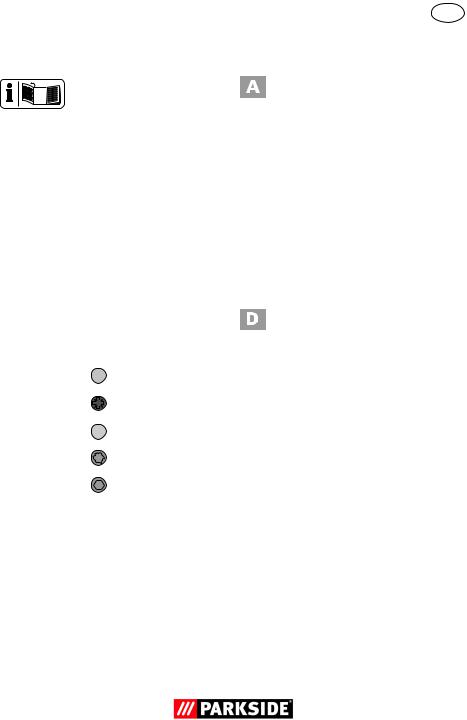
Opis ogólny
Rysunki znajdziesz na przedniej odchylanej stronie.
Zawartość opakowania
Rozpakuj urządzenie i sprawdź, czy jest ono kompletne.
Prawidłowo posegreguj i usuń materiały opakowania.
-Wkrętarka akumulatorowa
-Ładowarka
-26 Końcówki
-1 Przedłużka końcówki
-Walizka
-Instrukcja obsługi
26 Końcówki:
końcówka |
SL |
|
|
|
|
|
|
25mm |
nr |
3 |
• 4 • 5 • 6 • 7 |
prosta |
|
|
|
|
|
|
50mm |
nr |
5 |
|
|
|
|
|
|
|
|
||||||
|
|
|
|
|
|
|
|
||||
|
|
|
|
|
|
|
|
|
|
|
|
końcówka |
PZ |
|
|
|
|
|
|
25mm |
nr |
0 • 2 x 1• 2 x 2• 3 |
|
krzyżakowa |
|
|
|
|
|
|
50mm |
nr |
2 |
|
|
|
|
|
|
|
|
|
|
||||
|
|
|
|
|
|
|
|
|
|
|
|
końcówka |
PH |
|
|
|
|
|
|
25mm |
nr |
0 • 2 x 1• 2 x 2• 3 |
|
krzyżakowa |
|
|
|
|
|
|
|
|
|
|
|
|
|
|
|
|
|
|
|
|
|
|
|
|
|
|
|
|
|
|
|
|
|
||
końcówka torx T |
|
|
|
|
|
|
25mm |
nr |
10• 15 • 20 • 25 |
||
|
|
|
|
|
|
|
|
|
|
|
|
końcówka |
H |
|
|
|
|
|
|
25mm |
nr |
3 |
• 4 • 5 |
sześciokątna |
|
|
|
|
|
|
|||||
|
|
|
|
|
|
|
|
|
|
|
|
PL
Przegląd
1 Tulejka sprężysta
2 Regulacja momentu dokręcania
3Wskaźnik stanu naładowania
(niewidoczny)
4Przycisk zwalniający do ustawiania rękojeści
5 Okno latarki
6 Rękojeść
7 Gniazdo ładowania
8 Włącznik/ wyłącznik
9 Przełącznik kierunku obrotów
10Latarka LED
11Uchwyt końcówki wiertarskiej
12Wtyk kabla ładowarki
13Ładowarka
14Końcówki
15Przedłużka końcówki
Opis działania
Wkrętarka akumulatorowa z możliwością ustawiania obrotów w prawo/ w lewo posiada 6 stopni momentu dokręcania, jeden stopień siły wiercenia i latarkę LED. Dodatkowo urządzenie można używać jako latarkę.
Funkcje elementów urządzenia są podane w poniższym opisie.
17
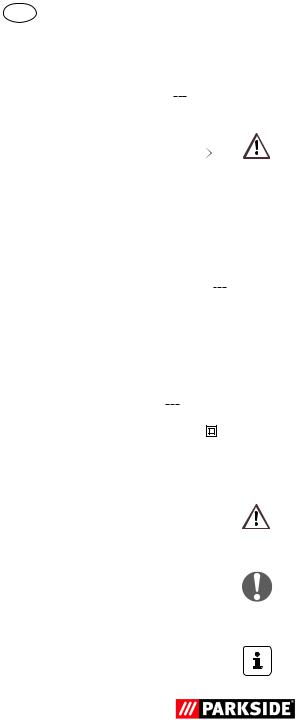
PL
Dane techniczne
Urządzenie |
|
|
|
|
|
|
|
|
|
Napięcie silnika............... |
|
3,6 V |
|
|
1,5 Ah |
||||
|
|
|
|||||||
Prędkość obrotowa przy pracy |
|
|
|
|
|
||||
jałowej (n0) |
............................... |
|
|
|
200 min-1 |
||||
Moment dokręcający............. |
maks. 4 Nm |
||||||||
Klasa zabezpieczenia..................... |
|
|
|
|
III III |
||||
Ciężar (bez .................ładowarki) |
|
0,43 kg |
|||||||
Poziom ciśnienia akustycznego |
|
|
|
|
|
||||
(LPA).......................... |
|
|
55,4 dB(A), K= 3 dB |
||||||
Poziom mocy akustycznej |
|
|
|
|
|
||||
(LWA) ........................ |
|
|
66,4 dB(A), K= 3 dB |
||||||
Wibracje (a ..........) |
0,37 m/s2, K= 1,5 m/s2 |
||||||||
|
h |
|
|
|
|
|
|
|
|
Akumulator (Li-Ion) |
|
|
|
|
|
|
|
|
|
Ilość ogniw .....................akumulatora |
1 |
||||||||
Napięcie ..............znamionowe |
|
3,6 V |
|
|
|||||
|
|||||||||
Pojemność................................ |
|
|
|
|
|
1,5 Ah |
|||
Czas ładowania........................ |
|
|
|
|
|
ok. 3 h |
|||
Ładowarka........... |
|
IVP0550-0550W |
|||||||
Znamionowy .............pobór prądu |
|
|
48 W |
||||||
Napięcie wejściowe/ |
|
|
|
|
|
||||
Input...... |
100 - 240 V~, 50/60 Hz, 0,2 A |
||||||||
Napięcie wyjściowe/ |
|
|
|
|
|
||||
Output....................... |
|
|
5,5 V |
|
|
550 mA |
|||
|
|
|
|
||||||
Moc wyjściowa..................... |
|
|
|
max. 6 W |
|||||
Klasa zabezpieczenia.................... |
|
|
|
II |
|||||
Typ zabezpieczenia...................... |
|
|
|
|
IPX0 |
||||
Wartości poziomu hałasu i wibracji ustalone zostały zgodnie z normami i przepisami wymienionymi w oświadczeniu zgodności. Zmiany techniczne i optyczne mogą być dokonywane bez zapowiedzi w trakcie udoskonalania produktu. W związku z tym wszelkie podane w niniejszej instrukcji
obsługi wymiary, wskazówki i dane nie posiadają gwarancji bezwzględnej prawidłowości. W związku z powyższym wyklucza się wszelkie roszczenia prawne zgłaszana na podstawie danych instrukcji obsługi.
Podana wartość emisji drgań została zmierzona metodą znormalizowaną i może być
18
wykorzystywana do porównań urządzenia elektrycznego z innymi urządzeniami. Podana wartość emisji drgań może też służyć do szacunkowej oceny stopnia ekspozycji użytkownika na drgania.
Ostrzeżenie:
Wartość emisji drgań może się różnić w czasie korzystania z urządzenia od podanej wartości, jest to zależne od sposobu używania urządzenia. Istnieje konieczność określenia i zastosowania środków ochrony użytkownika, opartych na ocenie ekspozycji w rzeczywistych warunkach używania urządzenia (należy przy tym uwzględnić wszystkie części cyklu roboczego, na przykład okresy czasu, w których urządzenie elektryczne jest wyłączone bądź jest włączone, ale pracuje bez obciążenia).
Zasady bezpieczeństwa
Przy używaniu maszyny należy przestrzegać tych zasad bezpieczeństwa.
Symbole i piktogramy
Symbole w instrukcji obsługi
Symbol niebezpieczeństwa z informacjami na temat ochrony osób i zapobiegania szkodom materialnym.
Znak nakazu (w miejscu wykrzyknika objaśnienie nakazu) z informacjami na temat zapobiegania szkodom.
Znak informacyjny ze wskazówkami ułatwiającymi posługiwanie się urządzeniem.

Symbole na urządzeniu
Przed pierwszym uruchomieniem urządzenia uważnie przeczytaj instrukcję obsługi.
Urządzeń elektrycznych i akumulator nie należy wyrzucać razem z odpadami domowymi
III |
Klasa zabezpieczenia III |
Symbole na ładowarce
Uwaga!
Przed rozpoczęciem ładowania przeczytać dokładnie instrukcję.
Ładowarka jest przeznaczona tylko do stosowania w pomieszczeniach.
Układ biegunów
Klasa zabezpieczenia II
Urządzeń elektrycznych nie należy wyrzucać razem z odpadami domowymi
Ogólne zasady bezpieczeństwa dotyczące narzędzi elektrycznych
OSTRZEŻENIE! Przeczytaj wszystkie zasady i instrukcje bezpieczeństwa. Niedokładne
przestrzeganie zasad i instrukcji bezpieczeństwa może spowodować porażenie prądem, pożar i/lub inne ciężkie zranienia.
PL
Zachowaj wszystkie zasady bezpieczeństwa i instrukcje na przyszłość.
Użyte w zasadach bezpieczeństwa pojęcie „narzędzie elektryczne“ dotyczy narzędzi elektrycznych zasilanych prądem sieciowym (za kablem sieciowym) oraz narzędzi elektrycznych zasilanych z baterii
(bez kabla sieciowego).
1) BEZPIECZEŃSTWO MIEJSCA PRACY
a)Zapewnij porządek i wystarczające oświetlenie w miejscu pracy.
Nieporządek lub nieoświetlone miejsce pracy może spowodować wypadek.
b)Nie pracuj narzędziem elektrycznym w atmosferze potencjalnie wybuchowej, w której znajdują się palne ciecze, gazy lub pyły.
Narzędzia elektryczne wytwarzają iskry, które mogą zapalić pył lub pary.
c)Trzymaj od dzieci i innych ludzi w bezpiecznej odległości podczas używania narzędzia elektrycznego. Odwrócenie uwagi może spowodować utratę kontroli nad urządzeniem.
2) BEZPIECZEŃSTWO ELEKTRYCZNE
a)Wtyczka narzędzia elektrycznego musi pasować do gniazdka. Wtyczki nie można w żaden sposób modyfikować. Nie używaj adapterów wtyczek razem z narzędziami elektrycznymi posiadającymi zestyk ochronny (uziemiający). Nienaruszone wtyczki i dopasowane gniazdka zmniejszają ryzyko porażenia prądem.
b)Unikaj dotykania uziemionych powierzchni, takich jak rury, kaloryfery, piecyki, kuchenki, lodówki. Gdy Twoje ciało jest uziemione, ryzyko porażenia prądem jest
19

PL
większe.
c)Trzymaj narzędzia elektryczne z daleka od deszczu i wilgoci/ wody. Dostanie się wody do wnętrza urządzenia elektrycznego zwiększa ryzyko porażenia prądem.
d)Nie używaj kabla do przenoszenia narzędzia elektrycznego, do jego zawieszania ani do wyciągania wtyczki z gniazdka. Chroń kabel przed gorącem, olejem, ostrymi krawędziami i ruchomymi częściami urządzenia. Uszkodzone i splątane kable zwiększają ryzyko porażenia prądem.
e)Pracując narzędziem elektrycznym na dworze, używaj tylko przedłużaczy dopuszczonych do używania na dworze. Używanie przedłużacza przystosowanego do używania na dworze zmniejsza ryzyko porażenia prądem.
f)Jeżeli nie da się uniknąć użycia narzędzia elektrycznego w mokrym otoczeniu, zastosuj wyłącznik ochronny (FI) o prądzie zadziałania 30 mA lub mniejszym.
Używanie wyłącznika ochronnego zmniejsza ryzyko porażenia prądem.
3) BEZPIECZEŃSTWO OSÓB
a)Zachowuj uwagę, uważaj na to, co robisz i pracuj narzędziem elektrycznym rozsądnie. Nie używaj narzędzi elektrycznych, jeżeli jesteś zmęczony albo jeżeli pod wpływem narkotyków, alkoholu albo leków. Chwila nieuwagi podczas używania narzędzia elektrycznego może doprowadzić do poważnych zranień.
b)Noś środki ochrony osobistej, zawsze zakładaj okulary ochron-
20
ne. Noszenie środków ochrony osobistej, takich jak maska przeciwpyłowa, buty z antypoślizgowymi podeszwami, kask i nauszniki − zależnie od rodzaju i sposobu używania narzędzia elektrycznego − zmniejsza ryzyko zranienia.
c)Unikaj przypadkowego uruchomienia narzędzia. Przed podłączeniem narzędzia elektrycznego do źródła zasilania i/lub baterii, przed jego podniesieniem i przeniesieniem upewnij się, że jest ono wyłączone. Jeżeli podczas przenoszenia narzędzia elektrycznego palec osoby niosącej znajdzie się na włączniku, albo jeżeli włączone urządzenie zostanie podłączone do źródła zasilania, może dojść do wypadku.
d)Przed włączeniem narzędzia elektrycznego usuń przyrządy nastawcze i klucze do śrub.
Narzędzie lub klucz znajdujący się w obrotowej części urządzenia może spowodować zranienie.
e)Unikaj anormalnych pozycji ciała. Zapewnij sobie stabilną pozycję i zawsze zachowuj równowagę ciała. Dzięki temu możliwe będzie zachowanie lepszej kontroli nad urządzeniem elektrycznym w nieoczekiwanych sytuacjach.
f)Noś odpowiednie ubranie. Nie zakładaj obszernych, luźnych ubrań ani ozdób. Trzymaj włosy, części ubrania i rękawice z daleka od ruchomych części. Luźne ubranie, ozdoby lub długie włosy mogą zostać pochwycone lub wkręcone przez ruchome części.
g)Jeżeli możliwy jest montaż przyrządów odsysających lub wychwytujących pył, upewnij się, że są one dobrze połączone i prawidłowo używane. Używa-

nie przyrządu odsysającego pył może zmniejszyć zagrożenia związane z pyłem.
4)EKSPLOATACJA I UŻYTKOWANIE ELEKTRONARZĘDZIA
a)Nie przeciążaj urządzenia. Do każdej pracy używaj właściwego narzędzia elektrycznego.
Pasującym narzędziem elektrycznym można pracować lepiej i bezpieczniej w podanym zakresie mocy.
b)Nigdy nie używaj narzędzia elektrycznego z uszkodzonym wyłącznikiem. Narzędzie elektryczne, którego nie można włączyć i wyłączyć, jest niebezpieczne i wymaga naprawy.
c)Przed rozpoczęciem ustawiania urządzenia, wymiany akcesoriów oraz przed odłożeniem urządzenia wyjmij wtyczkę z gniazdka i/lub wyjmij baterię.
Ten środek ostrożności uniemożliwi przypadkowe uruchomienie narzędzia elektrycznego.
d)Przechowuj nieużywane narzędzia elektryczne w niedostępnym dla dzieci miejscu. Nie pozwalaj używać urządzenia osobom, które nie są z nim obeznane i które nie przeczytały tych wskazówek.
Narzędzia elektryczne są niebezpieczne, jeżeli używają ich niedoświadczone osoby.
e)Starannie pielęgnuj narzędzia elektryczne. Sprawdzaj, czy ruchome części prawidłowo funkcjonują i nie są zablokowane, czy części nie są połamane lub inaczej uszkodzone i czy prawidłowe działanie narzędzia elektrycznego nie jest zakłócone.
PL
Przed użyciem urządzenia zleć naprawę uszkodzonych części. Przyczyną wielu wypadków są źle konserwowane narzędzia elektryczne.
f)Narzędzia tnące muszą być zawsze ostre i czyste. Starannie pielęgnowane narzędzia tnące z ostrymi ostrzami rzadziej się blokują i są łatwiejsze w prowadzeniu.
g)Używaj narzędzia elektrycznego, akcesoriów, oprzyrządowania itd. tylko zgodnie z tymi wskazówkami. Zwracaj przy tym uwagę na warunki pracy
i uwzględniaj rodzaj wykonywanej pracy. Używanie narzędzi
elektrycznych do celów niezgodnych z ich przeznaczeniem może prowadzić do niebezpiecznych sytuacji.
h)Podczas prac, przy których istnieje ryzyko natrafienia na ukryte przewody elektryczne lub własny kabel zasilający urządzenie należy trzymać za zaizolowane uchwyty. Kontakt z przewodem będącym pod napięciem może spowodować, że także metalowe części urządzenia znajdą się pod napięciem i staną się przyczyną porażenia prądem elektrycznym.
5)EKSPLOATACJA I UŻYTKOWANIE NARZĘDZIA ZASILANEGO Z AKUMULATORA
a)Ładuj akumulatory tylko przy użyciu zaleconych przez producenta ładowarek. Używanie ładowarki przystosowanej do jednego typu akumulatorów do ładowania akumulatorów innego typu grozi pożarem.
b)Stosuj w urządzeniach elektrycznych tylko przystosowane do nich akumulatory. Używanie innych
21

PL
akumulatorów może prowadzić do zranień i pożaru.
c)Trzymaj nieużywane akumulatory z daleka od spinaczy biurowych, monet, kluczy, gwoździ, śrub i innych drobnych przedmiotów metalowych, które mogłyby spowodować połączenie biegunów. Zwarcie między biegunami akumulatora może spowodować oparzenia lub pożar.
d)Nieprawidłowe stosowanie może doprowadzić do wycieku elektrolitu z akumulatora Unikaj kontaktu z elektrolitem. Jeżeli elektrolit zetknął się z oczami, umyj oczy wodą. Jeżeli elektrolit dostał się do oka, skorzystaj dodatkowo z pomocy lekarskiej.
Wyciekający z akumulatora elektrolit może spowodować podrażnienia skóry lub oparzenia.
6) SERWIS
a)Zlecaj naprawy narzędzia elektrycznego tylko wykwalifikowanemu personelowi i tylko
z użyciem oryginalnych części zamiennych. Pozwoli to zachować bezpieczeństwo użytkowania narzędzia elektrycznego.
7)SPECJALNE ZASADY BEZPIECZEŃSTWA DOTYCZĄCE URZĄDZEŃ
ZASILANYCH AKUMULATORAMI
a)Nie wystawiaj narzędzia elektrycznego przez dłuższy czas na silne promieniowanie słoneczne i nie kładź go na kaloryferze.
Gorąco może spowodować uszkodzenie
akumulatora i wybuch.
b) Przed rozpoczęciem ładowania
22
zaczekaj, aż nagrzany akumulator ostygnie.
c)Nie otwieraj akumulatora i chroń go przed mechanicznymi uszkodzeniami. Niebezpieczeństwo zwarcia i wydzielenia par drażniących drogi oddechowe. Zapewnij sobie dopływ świeżego powietrza, a razie wystąpienia dolegliwości skorzystaj dodatkowo z pomocy lekarskiej.
Prawidłowe obchodzenie się z ładowarką
a)Urządzenie to mogą obsługiwać także osoby o zmniejszonych zdolnościach fizycznych, zmysłowych czy umysłowych, czy też osoby dysponujące niedostatecznym doświadczeniem oraz wiedzą, pod warunkiem, że praca odbywa się pod nadzorem albo po instruktażu w zakresie bezpiecznej eksploatacji urządzenia i ze zrozumieniem istniejących zagrożeń. Dzieciom nie wolno bawić się urządzeniem.
b)Nie ładować ładowarką baterii nienadających się do ładowania.
c)Do ładowania akumulatorów
używaj wyłącznie dostarczonej ładowarki Niebezpieczeństwo pożaru
i wybuchu.
d)Przed każdym użycie sprawdzaj ładowarkę, jej kabel i wtyczkę; naprawy zlecaj tylko wykwalifikowanemu personelowi i tylko z użyciem oryginalnych części zamiennych. Nie używaj uszkodzonej ładowarki i nie otwieraj jej sam. Zapewni to bezpieczeństwo urządzenia.
e)Podłączaj ładowarkę tylko do gniazdka z zestykiem uziemia-
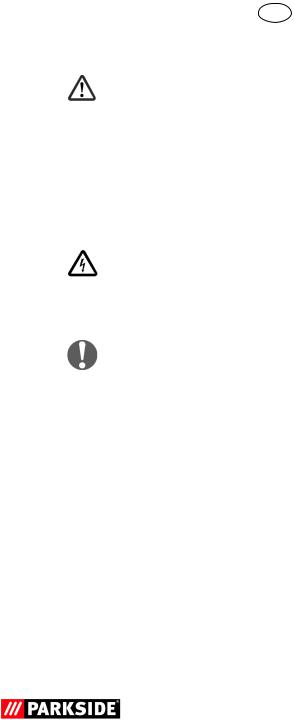
jącym. Uważaj, by napięcie sieciowe było zgodne z danymi znajdującymi się na tabliczce znamionowej znajdującej się na ładowarce. Niebezpieczeństwo pora-
żenia prądem.
f)Przed rozłączeniem i połączeniem złączy między akumulatorem/narzędziem elektrycznym/ urządzeniem zawsze odłączaj ładowarkę od sieci.
g)Utrzymuj urządzenie w czystości, nie wystawiaj go na działanie wilgoci i deszczu. Nigdy nie używaj ładowarki na dworze. Zabrudzenie ładowarki i dostanie się wody do jej wnętrza zwiększa ryzyko porażenia prądem.
h)Ładowarkę wolno stosować wyłącznie z oryginalnymi akumulatorami. Ładowanie innych akumulatorów może prowadzić do zranień i pożaru.
i)Unikaj mechanicznych uszkodzeń ładowarki. Mogą one powodować wewnętrzne zwarcia
j)Ładowarki nie wolno używać na palnym podłożu (np. papier, tekstylia). Niebezpieczeństwo pożaru wskutek nagrzania wywołanego ładowaniem.
k)Aby zmniejszyć ryzyko porażenia prądem elektrycznym, przed czyszczeniem urządzenia wyciągnąć wtyk ładowarki z gniazda sieciowego.
l)Jeżeli kabel zasilający tego urządzenia jest uszkodzony, musi on zostać wymieniony przez producenta lub jego serwis albo osobę posiadającą podobne kwalifikacje - tylko w ten sposób można zapewnić bezpieczeństwo urządzenia.
PL
Proces ładowania baterii
Nie narażać akumulatora na działania warunków ekstremalnych, takich jak ciepło czy uderzenia. Niebezpieczeństwo odniesienia obrażeń na skutek wycieku roztworu elektrolitu!
W przypadku kontaktu z elektrolitem spłukać wodą albo neutralizatorem i udać się do lekarza, jeżeli doszło do kontaktu z oczami itp.
Akumulator ładować tylko w suchych pomieszczeniach. Istnieje ryzyko odniesienia obrażeń na skutek porażenia prądem elektrycznym.
Ładować tylko załączoną w komplecie, oryginalną ładowarką. Pamiętać o tym, żeby nie ładować urządzenia ciągle przez czas dłuższy niż 3 godziny. Akumulator i urządzenie można uszkodzić, a przy dłuższym czasie ładowania niepotrzebnie zużywa się energię. W przypadku przeładowania użytkownik traci uprawnienia z tytułu gwarancji.
•Urządzenie należy zasilać tylko napięciem bezpiecznym zgodnie z oznaczeniem na urządzeniu (Safety Extra Low Voltage, bezpieczne niskie napięcie).
•Przed pierwszym użyciem należy naładować akumulator.
•Jeżeli urządzenie pracuje zbyt wolno, należy naładować akumulator.
•Należy zawsze przestrzegać obowiązujących wskazówek bezpieczeństwa, przepisów i wskazówek dotyczących ochrony środowiska.
23

PL
•Uszkodzenia wynikłe z nieprawidłowego użytkowania nie są objęte gwarancją.
Ładowanie akumulatora
1.Połączyć wtyk kabla ładowarki
(12)z gniazdem ładowania (7).
2.Podłączyć ładowarkę (  13) do gniazda sieciowego.
13) do gniazda sieciowego.
3.Wskaźnik stanu naładowania
(3)świeci się:
Czerwona dioda LED świeci się:
Akumulator ładuje się.
Zielona dioda LED świeci się: akumulator jest naładowany.
4.Po ukończeniu ładowania odłą-
czyć ładowarkę (  13) od sieci.
13) od sieci.
Uruchamianie
Włączanie i wyłączanie
1.W celu załączenia urządzenia wcisnąć włącznik/wyłącznik
(8). Latarka LED (10) świeci się podczas pracy urządzenia.
2.W celu wyłączenia zwolnić włącznik/wyłącznik (8).
Zabezpieczenie przeciążeniowe: W przypadku przeciążenia wyłącznik ochronny wyłącza urządzenie. Zwolnić włącznik/ wyłącznik, po kilku sekundach można ponownie załączyć urządzenie.
24
Sprawdzanie stanu naładowania akumulatora
Wskaźnik stanu naładowania ( 3) sygnalizuje stan naładowania akumulatora.
3) sygnalizuje stan naładowania akumulatora.
•Wcisnąć włącznik/wyłącznik, stan naładowania akumulatora sygnalizowany jest przez zaświecenie się 3 ko-
lorowych diod:
Zielona dioda LED świeci się jasnym światłem: Akumulator jest w pełni na-
ładowany.
Czerwona i żółta dioda świecą się jasnym światłem: Akumulator posiada
jeszcze rezerwę energii (< 90 %).
Czerwona dioda LED świeci się jasnym światłem: Akumulator jest pusty, naładować akumulator.
Ustawianie kierunku obrotu
Za pomocą przełącznika kierunku obrotów można wybrać kierunek obrotów urządzenia (obroty w prawo i obroty w lewo) i zabezpieczyć urządzenie przed niechcianym załączeniem.
1.Odczekać, aż urządzenie się zatrzyma.
2. Bieg w prawo: Wcisnąć  przełącznik kierunku obro-
przełącznik kierunku obro-
tów (9) w prawo.
3. Bieg w lewo: Wcisnąć  przełącznik kierunku obrotów (9) w lewo.
przełącznik kierunku obrotów (9) w lewo.
4.Blokada włącznika: Przełącznik kierunku obrotów ustawić w położeniu środkowym.
Przełącznik kierunku obrotów można przełączać tylko w stanie spoczynku urządzenia, aby nie uszkodzić przekładni.
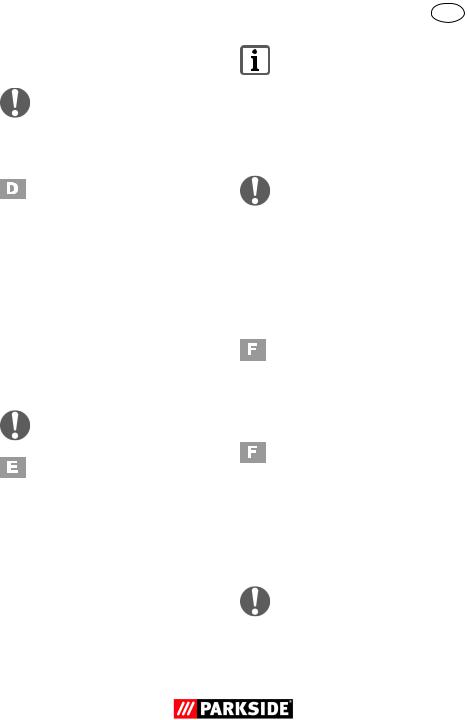
Zakładanie i wymiana końcówek
Przed wykonaniem wszelkich prac na urządzeniu przełącznik kierunku obrotów ( 9) ustawić w położeniu środkowym, aby zapobiec niechcianemu załączeniu.
9) ustawić w położeniu środkowym, aby zapobiec niechcianemu załączeniu.
1.Włożyć żądaną końcówkę (14) lub przedłużkę końcówki (15) do uchwytu końcówki wiertarskiej (11). Słychać jej zatrzaśnięcie.
2.W celu wyjęcia końcówki lub przedłużki odciągnąć tulejkę sprężystą (1).
3.Przy odciągniętej tulejce sprężystej (1) wyciągnąć końcówkę lub przedłużkę końcówki z uchwytu końcówki wiertarskiej (11). Zwolnić tulejkę sprężystą.
Regulacja momentu dokręcania
Przed ustawieniem momentu dokręcania wyłączyć urządzenie.
1.Wybrać żądany moment dokręcający przez odpowiednie obrócenie pierścienia nastawczego
(2):
Stopień 1 -->
najniższy moment dokręcający, Stopień MAKS. -->
najwyższy moment dokręcający
(4 Nm).
Wkręcanie: Stopień 1 - 6
Wiercenie: Stopień MAKS.
2.Rozpocząć pracę od mniejszego stopnia momentu dokręcania i w razie potrzeby zwiększyć go.
PL
Wymagany moment dokręcający zależy od:
-rodzaju i twardości obrabianego materiału;
-rodzaju i długości zastosowanych śrub.
Ustawianie rękojeści
Przed wykonaniem wszelkich prac na urządzeniu przełącznik kierunku obrotów ( 9) ustawić w położeniu środkowym, aby zapobiec niechcianemu załączeniu.
9) ustawić w położeniu środkowym, aby zapobiec niechcianemu załączeniu.
Urządzenie można zablokować w dwóch pozycjach rękojeści:
-pozycja chwytu pistoletowego
-pozycja chwytu prostego
Wcisnąć przycisk zwalniający PRESS (4) i obrócić rękojeść (6) urządzenia o 180°. Słychać jej zatrzaśnięcie.
Użycie jako latarki
1.Nacisnąć na okno latarki (5) na spodniej stronie rękojeści (6). Diody latarki zapalają się.
2.W celu wyłączenia diod ponownie nacisnąć na okno latarki (5).
Oczyszczani i konserwacja
Prace, które nie zostały opisane w tej instrukcji obsługi, musi wykonywać nasze Centrum Serwisowe.
Stosuj tylko oryginalne części.
25
